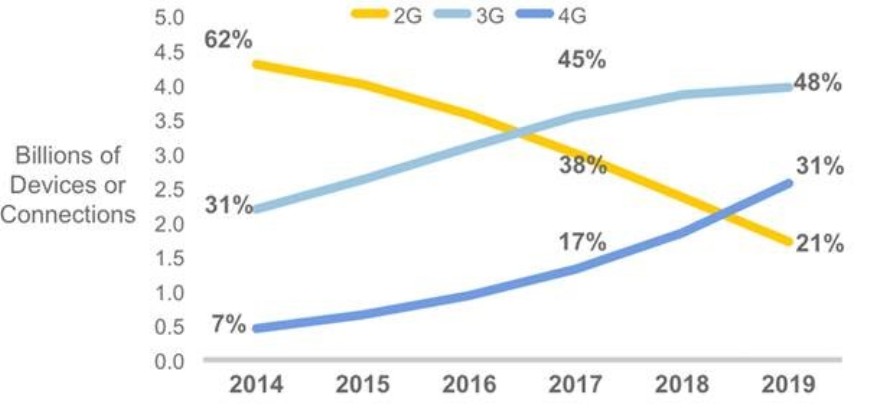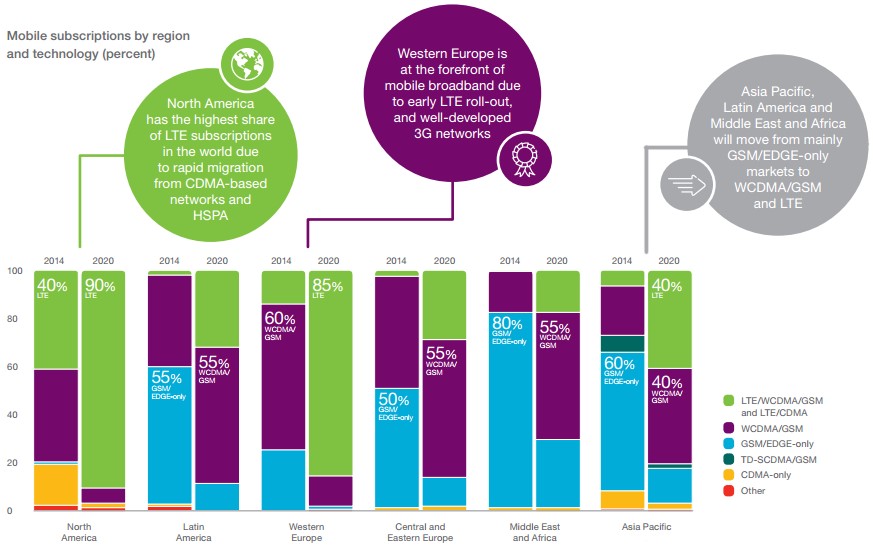As we enter the second half of the 4G LTE decade (2010—2020), industry visionaries and standards bodies start to discuss what 5G might look like, the requirements, and what it will bring to the end-user.
But as the future of 5G is still being defined, there is much uncertainty around what 5G will actually be once it comes to fruition. If the main goal for 5G is to improve people’s lives, the development of 5G should consider the various use cases for 5G. Additionally, 5G networks should seek to address the challenges faced by current network architectures.
But what are some of these challenges and is the introduction of yet another air interface the answer to solving them?
The defining challenge of the next ten years will be to efficiently deploy and manage networks that are becoming more complex in order to address the challenges of increasing data usage and higher density. The issue with managing these networks is that they comprise of several different technologies and air interfaces.
 Just look at telecom news headlines to see examples of this: “South Korea boasts some of the most expansive 4G LTE coverage”, “Vendor A partners with Service Provider B to provide free Wi-Fi”, “3G is going strong in many markets worldwide”. Additionally, 2G technologies are still in play and will be for some time. This begs the question of how all these technologies and networks are going to co-exist.
Just look at telecom news headlines to see examples of this: “South Korea boasts some of the most expansive 4G LTE coverage”, “Vendor A partners with Service Provider B to provide free Wi-Fi”, “3G is going strong in many markets worldwide”. Additionally, 2G technologies are still in play and will be for some time. This begs the question of how all these technologies and networks are going to co-exist.
Varying network maturity in different regions requires a solution that can address older generation technologies while managing future networks – what will work for the US likely won’t be a good option for less developed markets. One example of this is with the Indian market, which still largely uses 3G networks and is still making investments into 4G. If 5G is set to be another air interface introduced within the next five years, does this mean that networks in India and other countries with older generation networks will have to simply skip over 4G? Another example of this is in Western European markets where 4G LTE investments are projected to increase dramatically over the next few years.
 With operators in these regions set to make such large investments in 4G, it would be unreasonable to require them to make investments into 5G immediately after, thus making their 4G investments obsolete. The main goal of 5G, whatever it may be in the end, is to maximize any previous investments while delivering on the promise of the new use cases.
With operators in these regions set to make such large investments in 4G, it would be unreasonable to require them to make investments into 5G immediately after, thus making their 4G investments obsolete. The main goal of 5G, whatever it may be in the end, is to maximize any previous investments while delivering on the promise of the new use cases.
In order to efficiently manage all these older-gen networks, the future of telecom must embrace a true HetNet environment and converge existing radio access technologies under one umbrella: 5G. This would allow service providers to manage their networks more easily and cost-effectively as they would only need to manage the unified 5G network, rather than a mix of 2G, 3G, 4G, and 5G networks.
As currently the only consensus on 5G is on the use cases, this HetNet interpretation of 5G should be driven by said use cases with various network technologies being used for different situations. Though most vendors, operators, and analysts can agree on many of the use cases for 5G, Signals Research Group correctly points out in their report “Get Smart[er]”, that “each use case places a different burden on the network infrastructure”.
If 5G were to adopt this vision of a hyperconnected network, the various technologies of 2G, 3G, and 4G could be applied to specific use cases based on their requirements to relieve this burden: 5G will be focused on the dense capacity layer, while the macro coverage umbrella will probably remain 4G for many years. This is just one example of how different network technologies can be used in certain use cases to provide a more seamless experience.
The top three levels for 5G use cases are outlined in 5GPP’s latest 5G vision brochure:
Mission critical services – Government initiatives such as FirstNet in the US and ESMCP in the UK are making investments to move from outdated LMR and Tetra systems towards more reliable LTE. By making 5G a new radio access technology, investments made by these agencies into 4G would depreciate and these agencies would be required to once again invest into upgrading their devices and equipment.
User experience continuity – Varying market maturity results in different generation air interfaces being used in different regions around the world. A unified approach to 5G would enable seamless mobility for users and would minimize investments on behalf of global operators.
Internet of Things – As we move closer to the vision of a Connected World with Internet of Things, effective spectrum utilization becomes key. IoT is a major use case for 5G (also listed as a top three use case by NGMN’s paper on 5G deployment scenarios), but introducing it as a new radio access technology does not enable efficient spectrum utilization as it would force users and machines to communicate over the same air interface, leading to congestion and poor network performance. By unifying existing technologies under the 5G umbrella, IoT would then be able to utilize less commonly used networks such as 2G for M2M communications, while leaving 3G and 4G networks open for user access.
 The major impact of 5G will be around making a social impact on people’s lives worldwide – giving Internet access to everyone even in the most remote areas of the world. As operators in those regions are still making 3G/4G investments, expecting them to make more investments into 5G will hinder this mission of giving access to everyone. This social impact can only be achieved if the goal of 5G is around the unification of technologies and NOT introducing new network functions and new equipment.
The major impact of 5G will be around making a social impact on people’s lives worldwide – giving Internet access to everyone even in the most remote areas of the world. As operators in those regions are still making 3G/4G investments, expecting them to make more investments into 5G will hinder this mission of giving access to everyone. This social impact can only be achieved if the goal of 5G is around the unification of technologies and NOT introducing new network functions and new equipment.
5G does not need to be a disruptive revolution, but instead it should be an evolution that delivers better network performance for all. Unifying these existing technologies as a hyperconnected RAN would enable service providers to address the challenges as a whole, rather than individually and would avoid further complicating the networks by introducing a new technology. Signals Research summarizes this vision well: “the 5G network simply brings everything together but the key difference is that the control mechanisms now fall under the domain of the 5G service provider.” If we were to adopt this mindset as we continue to outline the future of 5G, network unification would surely ring out as the ideal solution.
Article contributed by Parallel Wireless
[email protected]





